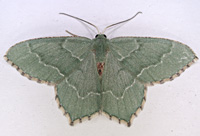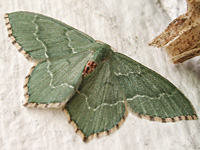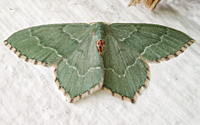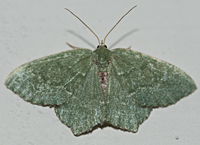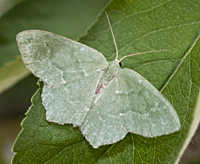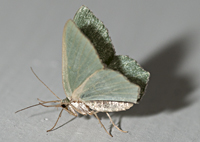[All pictures of garden wildlife on this page are thumbnails. Click on any thumbnail for a large format to be displayed.]

Common Emerald (Hemithea aestivaria)
| Taxonomy | ||||||
|---|---|---|---|---|---|---|
| Kingdom: | Phylum: | Class: | Order: | Family: | Genus: | Species: |
| Animalia | Arthropoda | Insecta | Lepidoptera | Geometridae | Hemithea | H. aestivaria |
A strikingly green and very beautiful Geometer. You'll notice immediately the chequered fringes and the two-coloured body: green at first, then abruptly becoming brownish red. The only species that does look like it is the Sussex Emerald, which has two points on each hindwing, where the Common Emerald has just one. The body of the Sussex Emerald is entirely green. Even though worn animals have a lighter green colour, the Common Emerald doesn't fade to yellow or white, like so many other green Geometers do. In the lower 3 photographs you see an example of older Common Emerald with green colour still being vibrant and the pattern on the wings still distinct. It is only the dotted light rim of the wings that disappeared.
Reaching a wingspan of some 29 to 34 mm this moth isn't very big, The eggs hatch late in summer. The caterpillars do not grow very fast. They are bright green usually, having reddish brown V-shaped markings on the back. There are however brownish animals as well. These also have V-shaped markings on the back, but in white. Sometimes there is a blackish dorsal line. On both the head and the thorax are small bumps. The head is brownish and deeply cleft. The larvae eat at night and rest in the typical Geometer position at day: imitating a small twig. The half grown caterpillar overwinters. After having completed their development in spring they spin together a few leaves in which they make a cocoon and in it they pupate. The larvae reach a length of some 23 mm and are highly polyphagous. They can be found on a great number of trees, shrubs and even lower plants.
The Common Emerald has just one generation. It is on the wing in June and July in Southern England, but in July only going northwards. It flies by night only, often seen visiting flowers in gardens, even in city centers. It is attracted to light, but in very small numbers only. Hard to find resting during the day between foliage, but easy to spot when resting on walls or fences. Abundant in the south of England, getting scarcer northwards. In Scotland very rarely seen and in the south only. A very common species on the continent, but rare or lacking in most of Scandinavia and other northern parts.

© Copyright 1998-2024 gardensafari.net (Hania Berdys)

 English / engels
English / engels  Dutch / nederlands
Dutch / nederlands